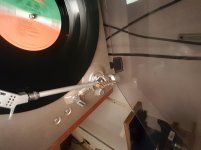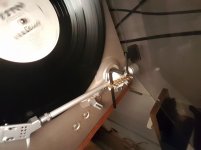Got my first MC cartridge yesterday, a DL-103. I didn't do enough research on these, and it seems my DP300-F's 11 gram tonearm is too light for this. I experimented with adding some blutack on the headshell, but didn't like the results. So I noticed an unused copper bus terminal (68 grams) fits snugly at the fulcrum of the tonearm, adding mass inertia, without drastically affecting the anti skating adjustment, like the far from the fulcrum blutack. As long as we're subjective hear, I think it sounds much better in every way.
A shopowner who just happens to sell turntables says it can't work, and I should buy one his turntables, with a modified arm.
Any one care to take sides here? I believe it's damping resonances, and resisting lateral deflection with added mass, while not changing a 2.3 gram vertical tracking force, but I have little empirical experience with turntable setup.
Sorry about the image. It rotates 90° no matter what I do with it.
A shopowner who just happens to sell turntables says it can't work, and I should buy one his turntables, with a modified arm.
Any one care to take sides here? I believe it's damping resonances, and resisting lateral deflection with added mass, while not changing a 2.3 gram vertical tracking force, but I have little empirical experience with turntable setup.
Sorry about the image. It rotates 90° no matter what I do with it.
Attachments
Yes I know it's completely bonkers. Dan claimed he had these bit-identical files that sounded different, and after he said it a bunch somebody said "OK, let's see them then." I for one never expected him to actually put up the files, but once he did I felt obliged to check them out. My expectation, of course, was that either the files are different, or they sound the same, since those are the only possibilities. They are identical, and they sound identical.This thread still hijacked by the snake oil maker. And people are actually trying to hear a difference in bit identical files. The loonies are taking over the loony bin.
Notice he keeps claiming new folks hear the difference while in his presence, yet 0.0% of listeners here have heard a difference. The distinguishing factor is obvious.
There is a way to do a live test over the internet. Stream the audio and video from Max Headroom's location with a top down view on a large table with all of the listening equipment in view (from power outlet to speakers) with a HD 1080p webcam live feed showing clearly what he is doing so that everyone can see that there is no trickery afoot. Ensure that the audio stream is as high bitrate as possible.
Then max buy's two brand new cables completely sealed in blister packs which will then remain in frame at all times and proven to be completely sealed by showing them to the camera up close. I'm not entirely sure how long the treatment takes but I'm sure that people on the forum can take turns watching the live feed to ensure that the cables aren't tampered with aside from the treatment.
Then Max will open up both packages and treat one and not the other in our view on the camera.
Then one or two people whom the forum trusts will watch the live feed and during the ABX test the rest of us will only listen but not watch the live feed. This is so that we can verify that Max isn't swapping the cables with another one that has been modified off camera, while the rest of us listen into only the audio of the live feed. We would have to somehow cover our monitors with a black sheet as the live feed plays for the duration of the test. Or turn off the monitor and leave only the audio going.
Then once the test is over Max will say its over on the forum or live feed and we all remove the black cover or turn our monitors on and then post our results on the forum.
The video and audio will then be recorded and kept as evidence to be played back later on for the ABX comparison.
Then max buy's two brand new cables completely sealed in blister packs which will then remain in frame at all times and proven to be completely sealed by showing them to the camera up close. I'm not entirely sure how long the treatment takes but I'm sure that people on the forum can take turns watching the live feed to ensure that the cables aren't tampered with aside from the treatment.
Then Max will open up both packages and treat one and not the other in our view on the camera.
Then one or two people whom the forum trusts will watch the live feed and during the ABX test the rest of us will only listen but not watch the live feed. This is so that we can verify that Max isn't swapping the cables with another one that has been modified off camera, while the rest of us listen into only the audio of the live feed. We would have to somehow cover our monitors with a black sheet as the live feed plays for the duration of the test. Or turn off the monitor and leave only the audio going.
Then once the test is over Max will say its over on the forum or live feed and we all remove the black cover or turn our monitors on and then post our results on the forum.
The video and audio will then be recorded and kept as evidence to be played back later on for the ABX comparison.
Good people are trying as a courtesy to a member. Nothing to be alarmed about. Not the end of the world.
I agree with Mark, at this point the acrimony serves no purpose it takes two to waste time at this so just ignore it if that suits you. I still think Dan is open to being wrong unlike the Bybee crowd.
Mostly I say only "this prototype may or may not change your sound", sometimes I say "this prototype might change your sound".
In the case of musicians/buskers/sound engineers I let them call fit/remove/restore...etc and they play what they want of course.
In the case of playback systems I let the subject choose the tunes and make the calls.
When the subject is done, I often get a range of quizzed looks and always a bunch of so far universally positive reactions and appraisals.
Most of the time I also get "where do I get some and how much ?".
The simple act of presenting a mysterious device and clipping it onto cables is perhaps instilling positive bias in itself, but the appraisals/descriptions make moot such argument ime.
Dan.
This is very disappointing, you are not understanding some very fundamental rquirements of testing a hypothesis. You could in fact be getting subjects to fuel your own expectation bias.
You give people two identical things and tell them either of both might do something or nothing then with no further interaction ask them what they think.
Any one care to take sides here? I believe it's damping resonances, and resisting lateral deflection with added mass, while not changing a 2.3 gram vertical tracking force, but I have little empirical experience with turntable setup.
Sorry about the image. It rotates 90° no matter what I do with it.
Interesting. A few months ago I would have said you have done something daft there, but the more I look at this (and angst over purchases) the more I realise that proper research hasn't been done, or at least collated together.
First up, despite all the people saying you need HUUUUUGE mass with a DL-103 I don't believe that to be the case. I reckon your tonearm should be fine as it and give a resonance around 11-12Hz, which is about perfick IMO.
Your busbar is adding to effective mass, but inefficiently as near pivot and with more effect in vertical plane than lateral. Would be interesting to turn it through 90 degrees and see how that works. If you have a way of recording digitally off the TT take some recordings with and without the bus bar and we can analyse the differences.
Note all of this is far too sensible for this thread
Couldn't devise a way to turn it 90°, so attached a couple allen key masts to add a little angular momentum. Still no need to adjust the anti skating, there does seem to be a little less glare on cymbals, without loss of resolution. Haven't noted any other sonic differences, thanks for the idea.
I can make a cdr on an old Tascam, but have no idea how to send that with a phone.
I can make a cdr on an old Tascam, but have no idea how to send that with a phone.
Attachments
Your busbar is adding to effective mass, but inefficiently as near pivot and with more effect in vertical plane than lateral.
I don't understand this. It looks like the bus bar does not move vertically, it is attached to the gimbal and only rotates horizontally. It should have no effect on vertical resonance. Am I missing something?
Am I missing something?
There could be pitch and yaw resonance modes. It would affect yaw, it looks like.
I don't understand this. It looks like the bus bar does not move vertically, it is attached to the gimbal and only rotates horizontally. It should have no effect on vertical resonance. Am I missing something?
Even rotating horizontally, it still adds inertia against horizontal movement, which low compliance cartridges need, if I understand what I've read in a few forums.
Billshurv's idea of changing things up 90° isn't soley addressed by the masts or outriggers here, but it has added more solid bass, and more focused highs. I chose the location after adding mass at the headshell, which I felt needed too much anti skate adjustment.
It is an inefficient location, but adds around 180 grams now, making up for this. I guess. I do know it sounds better on the weighted low mass arm, than the 22 gram S tonearm which is on my vintage Akai AP-206, with a 12 gram resin headshell.
Just one more quibble.
How is antiskate affected by mass? It is a function of stylus drag and geometry. Stylus drag is proportional to VTF, but not to effective arm mass per se. Did you use a test record to determine correct anti skate setting?
Edit:. This is far too useful to be in the snake oil thread, it should be in Analog Source.
I chose the location after adding mass at the headshell, which I felt needed too much anti skate adjustment.
How is antiskate affected by mass? It is a function of stylus drag and geometry. Stylus drag is proportional to VTF, but not to effective arm mass per se. Did you use a test record to determine correct anti skate setting?
Edit:. This is far too useful to be in the snake oil thread, it should be in Analog Source.
I don't understand this. It looks like the bus bar does not move vertically, it is attached to the gimbal and only rotates horizontally. It should have no effect on vertical resonance. Am I missing something?
There is the warp thing as well, and it definitely changes the arm's vertical as well as horizontal mass. The cartridge's stylus is moving in both planes and sees those masses through its compliance.
The 103 punches way above its weight particularly when installed in something better than the flimsy stock plastic shell. I have had a number of very low compliance cartridges including the Zu Denon DL-103, and a bunch of SPUs, although I suspect that my current strain gauges are lower still. I think 20 gms + of effective mass is warranted.
Based on limited experience and absolutely no measurements at all I still suspect you need additional mass. The best way to get it might be a heavier head shell, this presupposes that you can still balance the arm.
FWIW the first cartridge I have owned that I considered good over more than a short period of time was that Zu DL-103.
Just one more quibble.
How is antiskate affected by mass? It is a function of stylus drag and geometry. Stylus drag is proportional to VTF, but not to effective arm mass per se. Did you use a test record to determine correct anti skate setting?
Edit:. This is far too useful to be in the snake oil thread, it should be in Analog Source.
I use an acrylic mat. Once everything is set for weight, I let the stylus land on it while spinning the platter, and dial the anti skate until the arm swings to the halfway point of its swing.
I use an acrylic mat. Once everything is set for weight, I let the stylus land on it while spinning the platter, and dial the anti skate until the arm swings to the halfway point of its swing.
That's a new one on me..
Applying mass at the head shell should have absolutely no effect on bias required unless the arm bearings are so mediocre that adding significant mass out at the end of the arm results in a significant increase in friction, but I don't know why that would not also be the case to some extent with more mass added closer to the fulcrum.
That's a new one on me..It doesn't seem like a valid approach to me since the anti-skating force required is a function of arm geometry, stylus drag and radius. (The force required isn't constant) I suspect stylus geometry, and groove amplitudes also play a role since it affects drag, but I no longer have a way to check any of this as all of my arms are LTAs.
Applying mass at the head shell should have absolutely no effect on bias required unless the arm bearings are so mediocre that adding significant mass out at the end of the arm results in a significant increase in friction, but I don't know why that would not also be the case to some extent with more mass added closer to the fulcrum.
So where should the tonearm come to rest when the bias is set properly? Near the spindle, or the perimeter?
The tonearm swings easier than the Dual 506, Pro-Ject Elemental, or Akai 206 in house; I assumed this meant the DP 300-F has better bearings than those. There's also less rumble with it, but that involves more than the tonearm bearings. As to why the anti skate bias needed more with blutac added to the headshell and arm, I don't know.
LTA is linear tracking arms?
I remember being proud of a new Technics linear tracking table in the 80's; everyone immediately told me they were no good, because the masters were cut to account for pivoting arm playback. Tangential always made sense to me, especially P-mount.
My concern for buying a vintage one would be parts availability, as I found out with my (sniffle) Sony Biotracer. So I am hoping for a budget friendly new turntable solution, and so far this sounds great, to me. Subjectively, of course.
Last edited:
So where should the tonearm come to rest when the bias is set properly? Near the spindle, or the perimeter? <snip>
I don't have an answer as I am not even really sure that what you are doing is a valid approach. The idea behind applying anti-skating is to compensate for the dynamic forces involved in playback that force the stylus to the outside edge of the groove, so presumably to set it correctly you need to play an appropriate track on a test record and look at the resulting output on a scope or follow the manufacturer's guidance which might be approximately correct. My last 12 inch arms did not even have provisions for anti-skating (Schick and clone 3012), but likely should have.
Record cutters are tangential, and at one time RCA and others did predistort the inner grooves in an effort to correct for tracking error induced distortion. It's not common today and some record companies never did it at all. In general the tangential arms seem to do better on the inner grooves than comparably priced pivoted arms regardless of whether pre-distortion is used or not. (Bear in mind this is my own very limited experience with just 3 LTAs over just a couple of years. So I am no authority in any sense)
There are a number of new air bearing LTAs out of China and elsewhere sold on eBay, I have no idea whether they are any good or not. Old Southers are available from time to time on eBay, and there isn't much to go wrong with those, and used ET-2/2.5 show up from time to time. I have two Southers and an ET-2.
I'm trying a new technique of treating cables to improve the skin effect. Improving its elasticity and conductivity as a result.
I've also heard that little fluffy white pillows as cable stands works well, so does singing them bedtime stories.
Does anyone have any upset cables they would like me to treat?Formulated with snail mucus to refine skin texture & improve elasticity Provides instant freshness & vitality to skin Can also be used on hair. Leaves skin calm, soft, smooth & moist To use.
I've also heard that little fluffy white pillows as cable stands works well, so does singing them bedtime stories.
Attachments
Last edited:
- Status
- Not open for further replies.
- Home
- Member Areas
- The Lounge
- Funniest snake oil theories


